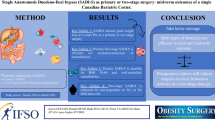Abstract
The elevated variety of procedures proposed for surgical treatment of obesity in the last few years suggests the necessity to find an ideal operation. Laparoscopic mini-gastric bypass (LMGB) was developed to obtain better results with lesser morbidity and mortality. LMGB was introduced by Rutledge, in 1997, and it consists of a long lesser-curvature tube with a terminolateral gastroenterostomy 180 cm distal to the Treitz ligament. From July 1995 to May 2011 we have performed 552 bariatric operations, among them we have operated 197 laparoscopic mini-gastric bypass (Fig. 1). There were 147 female (75%) and 50 male (25%) with the mean age of 37.9 years (range 20–55) and the mean BMI of 52.9 kg/m2. All procedures were completed laparoscopically, without conversion and the mean operative time was 120 min (range from 90 to 170 min). The average postoperative stay was 5.0 days. We report one case of mortality for pulmonary septic complications. Major complications were two cases of pulmonary embolism (treated in ICU), six cases of melena on seventh postoperative day and three cases of anastomotic ulcers resolved with high doses of PPI. We registered a significant reduction of BMI and percentage of excess weight after surgery with a significant improvement in obesity-related comorbidities including blood pressure, hyperglycemia, blood lipid, uric acid, and liver function. An ideal weight loss operation should be effective, easy to perform and safe. Laparoscopic Roux-en-Y Gastric Bypass is actually the “gold-standard” technique but LMGB seems to be an attractive alternative: shorter operative time, with less morbidity and mortality, easier to teach and to perform. Another advantage could be the presence of a single anastomosis alone reducing the possibility of leaks.

Totality of bariatric procedures in our experience

Similar content being viewed by others
References
Wittgrove AC, Clark GW, Tremblay LJ (1994) Laparoscopic gastric bypass, Roux-en-Y: preliminary report of five cases. Obes Surg 4:353–357
Lee WJ, Lai IR, Huang MT et al (2001) Laparoscopic versus open vertical banded gastroplasty for the treatment of morbid obesity. Surg Laparosc Endosc 11:9–13
Rutledge R (2001) The mini-gastric bypass: experience with the first 1, 274 cases. Obes Surg 11:276–280
Fisher BL, Buchwald H, Clark W et al (2001) Mini-gastric bypass controversy. Obes Surg 11:773–777
Wang W, Wei PL, Lee YC et al (2005) Short-term results of laparoscopic mini-gastric bypass. Obes Surg 15:648–654
Chakhtoura G, Zinzindohoué F, Ghanem Y et al (2008) Primary results of laparoscopic mini-gastric bypass in a French obesity-surgery specialized university hospital. Obes Surg 18:1130–1133
Schafer LW, Larson DE, Melton LJ 3rd et al (1983) The risk of gastric carcinoma after surgical treatment for benign ulcer disease. A population-based study in Olmsted County, Minnesota. N Engl J Med 309(20):1210–1213
Bassily R, Smallwood RA, Crotty B (2000) Risk of gastric cancer is not increased after partial gastrectomy. J Gastroenterol Hepatol 15(7):762–765
McNatt SS, Longhi JJ, Goldman CD et al (2007) Surgery for obesity: a review of the current state of the art and future directions. J Gastrointest Surg 11:382–402
Rutledge R (2007) Hospitalization before and after mini-gastric bypass surgery. Int J Surg 5:35–40
Rutledge R, Walsh TR (2005) Continued excellent results with the minigastric bypass: six-year study in 2, 410 patients. Obes Surg 15:1304–1308
Lee WJ, Wang W, Lee YC et al (2008) Laparoscopic mini-gastric bypass: experience with tailored bypass limb according to body weight. Obes Surg 18:294–299
Lanyon RI, Maxwell BM, Kraft AJ (2009) Prediction of long-term outcome after gastric bypass surgery. Obes Surg 19:439–445
Verset D, Houben JJ, Gay F et al (1997) The place of upper gastrointestinal tract endoscopy before and after vertical banded gastroplasty for morbid obesity. Dig Dis Sci 42:2333–2337
Ovrebo KK, Hatlebakk JG, Viste A et al (1998) Gastroesophageal reflux in morbidly obese patients treated with gastric banding or vertical banded gastroplasty. Ann Surg 228:51–58
Capella JF, Capella RF (1999) Gastro-gastric fistulas and marginal ulcers in gastric bypass procedures for weight reduction. Obes Surg 9:22–27
Sapala JA, Wood MH, Sapala MA et al (1998) Marginal ulcer after gastric bypass: a prospective 3-year study of 173 patients. Obes Surg 8:505–516
Conflict of interest
None.
Author information
Authors and Affiliations
Corresponding author
Rights and permissions
About this article
Cite this article
Piazza, L., Ferrara, F., Leanza, S. et al. Laparoscopic mini-gastric bypass: short-term single-institute experience. Updates Surg 63, 239–242 (2011). https://doi.org/10.1007/s13304-011-0119-y
Received:
Accepted:
Published:
Issue Date:
DOI: https://doi.org/10.1007/s13304-011-0119-y




